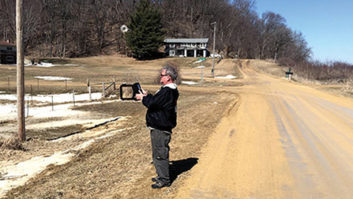Test and measurement in the digital age
Sep 1, 2004 12:00 PM, By Kevin McNamara, CNE
Maintaining quality and reliability in a modern digital facility presents some new and significant challenges when compared with traditional analog methods. A few engineers believe it is easier to maintain a digital audio chain because they no longer need to deal with the audible effects of ground loops, noise, crosstalk and mismatches typical in some analog signal paths. Digital signals, on the other hand, either provide flawless audio or dead silence, right? Wrong! Digital infrastructures require a great deal of care when designing, constructing and testing the various paths where digital audio signals travel.
Let’s envision a fully digital broadcast facility. It might house several fully automated stations under one roof. The operation requires a combination of digital and analog signal paths to handle the diversity of the various stations, however all of the program and production audio is fully digital to the transmitter site. Analog and digital signal are routed with a large multi-format routing switcher. The respective stations use an extensive digital microwave system. Several channels of digital audio (traditional and IBOC) are transmitted over a 45MHz DS3 radio system to one transmitter site (hub), then each digital channel is split off and fed to other stations over a lower bandwidth 1.5MHz DS1 microwave system. The facility also streams digital audio to the Internet, as well as real-time news, weather and traffic to various websites.

Ethernet testers can evaluate cables, but also provide information on network traffic.
I use this example to illustrate the variety of test and measurement requirements that are currently or will likely be in use the near future. Our facility uses several types of signals operating over a wide variety of protocols and transport methods. These signals include analog, AES/EBU digital and S/PDIF digital formats. The transport protocols that carry these audio formats include Ethernet, Fibre Channel, DS1and DS3 operating over physical media that include standard single pair shielded, CAT-5, fiber optic, coaxial and wireless media. Protocols such as TCP/IP and IPX are also used extensively for general office LAN and Web server applications.
If you are the engineer of this facility, here are a few pieces of essential test equipment that should be close at hand.
Cable tester
No toolbox should be without some type of cable tester. While most cable testers troubleshoot Ethernet cabling, some also offer the ability to analyze other cabling such as basic paired/shielded, coaxial and fiber optic media. Most networks rely on unshielded twisted pair cable (UTP) as a means to interconnect devices. Because the UTP cable uses copper conductors, it is subject to the usual electrical characteristics, notably signal attenuation and frequency losses that vary directly with its length. Currently, Ethernet networks operate in full-duplex, which means that transmitted and received data is carried simultaneously. Two of the four pairs within the UTP cable are used to transmit and receive. The problem with this arrangement is that the signal levels for transmitted and received data at any given termination point may have extremely different levels. This imbalance could create the problem of near-end cross talk (NEXT). NEXT is created when the transmitted electrical signal (current) on one pair of wires forms a magnetic field, which couples to the pair carrying the received signal. This problem generally occurs at the UTP cable end because this is where the transmitted signal is highest relative to that measured on the received pair, and because the cable pairs may be untwisted to facilitate attachment to the RJ-45 connector, promoting more efficient coupling.

Audio test generators and testers provide an easy way to verify performance.
The interference created as a result of NEXT can have severe effects on the performance of the network. For higher performances, Category 5e (CAT-5e) cabling or higher variations of the NEXT measurement are specified. These measurements include equal-level far-end crosstalk (ELFEXT), power sum near-level crosstalk (PSNEXT) and power sum equal-level crosstalk (PSELFEXT), which are derived from calculations, not a specific measurement.
Ethernet network analyzers
A network analyzer is a useful, albeit expensive, tool for documenting and troubleshooting LANs, WANs and even fibre-channel based storage area networks (SAN). These tools allow a network engineer to perform the cable testing functions previously discussed and to monitor and quantify the packets of data traffic moving across the network. These testers provide a comprehensive suite of tools that give several views of a network, including discovery of network devices attached to the network; detailed information about those devices including network addresses, names, type of device and protocols used; logical mapping of all devices and connections within a LAN or WAN; detailed IP information; network usage statistics; data performance measurements; and network error information.
Digital audio test systems
The digital audio interfaces prominent in radio broadcasting are either the AES/EBU or the S/PDIF format. While the formats are similar in many respects, the S/PDIF format is commonly associated with consumer electronics, and was formally standardized under a document called IEC958 (for professional and consumer electronics). The AES/EBU standard deals with professional digital audio applications. What is most similar is that each of these formats will operate without the benefit of external timing. The self-clocking feature makes it easy for a digital audio device to interface with other digital audio devices simply by setting the sample rates the same, usually 48kHz (professional) or 44.1kHz (consumer), although other (less common) rates can be used.
A variety of specialized test systems for the testing of digital audio systems are currently available. The test systems are packaged as stand-alone test systems, custom PC-based hardware/software analysis packages or a combination of both. Most professional digital audio systems use AES/EBU, specifically the AES3 standard, however most can also analyze S/PDIF signals.
The majority of problems found in digital audio systems can be traced to one of the following four conditions.
- Improper/defective cabling-The additional capacitance caused by excessively long or improperly terminated cables will increase the incidence of bit errors and consequently data losses in a system due to improper timing or insufficient amplitude to adjacent device.
- Insufficient signal amplitude-Because clocking/synchronization is derived from the transition of the data bits, digital stream may become unreliable or non-existent.
- Mismatched sample rate-This can be easily detected with a test device.
- Excessive jitter-Jitter can take different forms, but it can be generally described as any deviation from a perfectly stable clock signal. Jitter can be caused by improper cabling, high noise levels or excessive crosstalk.
An investment in the proper test equipment equates to significant savings of time and increased reliability.
McNamara is president of Applied Wireless.












